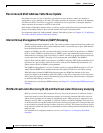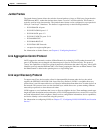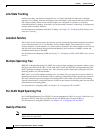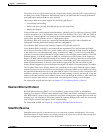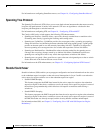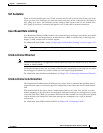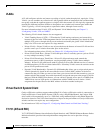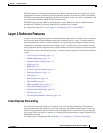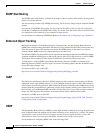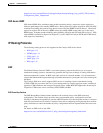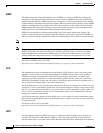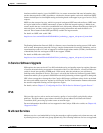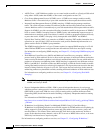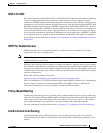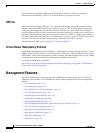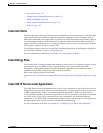
1-12
Software Configuration Guide—Release 15.0(2)SG
OL-23818-01
Chapter 1 Product Overview
Layer 3 Software Features
EIGRP Stub Routing
The EIGRP stub routing feature, available in all images, reduces resource utilization by moving routed
traffic closer to the end user.
The IP base image contains only EIGRP stub routing. The IP services image contains complete EIGRP
routing.
In a network using EIGRP stub routing, the only route for IP traffic to follow to the user is through a
switch that is configured with EIGRP stub routing. The switch sends the routed traffic to interfaces that
are configured as user interfaces or are connected to other devices.
For information on configuring EIGRP Stub Routing, see Chapter 30, “Configuring Layer 3 Interfaces.”
Enhanced Object Tracking
Before the introduction of the Enhanced Object Tracking feature, the Hot Standby Router Protocol
(HSRP) had a simple tracking mechanism that allowed you to track the interface line-protocol state only.
If the line-protocol state of the interface went down, the HSRP priority of the router was reduced,
allowing another HSRP router with a higher priority to become active.
The Enhanced Object Tracking (EOT) feature separates the tracking mechanism from HSRP and creates
a separate standalone tracking process that can be used by other Cisco IOS processes as well as HSRP.
This feature allows tracking of other objects in addition to the interface line-protocol state.
A client process, such as HSRP, Virtual Router Redundancy Protocol (VRRP), or Gateway Load
Balancing Protocol (GLBP), can now register its interest in tracking objects and then be notified when
the tracked object changes state.
For details on EOT, refer to this URL:
http://www.cisco.com/en/US/docs/ios/ipapp/configuration/guide/ipapp_eot.html
GLBP
The Gateway Load Balancing Protocol (GLBP) feature provides automatic router backup for IP hosts
configured with a single default gateway on a LAN. Multiple first hop routers on the LAN combine to
offer a single virtual first hop IP router while sharing the IP packet forwarding load. GLBP devices share
packet-forwarding responsibilities, optimizing resource usage, thereby reducing costs. Other routers on
the LAN may act as redundant GLBP routers that will become active if any of the existing forwarding
routers fail. This improves the resiliency of the network and reduces administrative burden.
For details on GLBP, refer to this URL:
http://www.cisco.com/en/US/docs/ios/ipapp/configuration/guide/ipapp_glbp_ps6350_TSD_Products_
Configuration_Guide_Chapter.html
HSRP
The Hot Standby Router Protocol (HSRP) provides high network availability by routing IP traffic from
hosts on Ethernet networks without relying on the availability of any single Layer 3 switch. This feature
is particularly useful for hosts that do not support a router discovery protocol and do not have the
functionality to switch to a new router when their selected router reloads or loses power.
For information on configuring HSRP, refer to the following URL:



